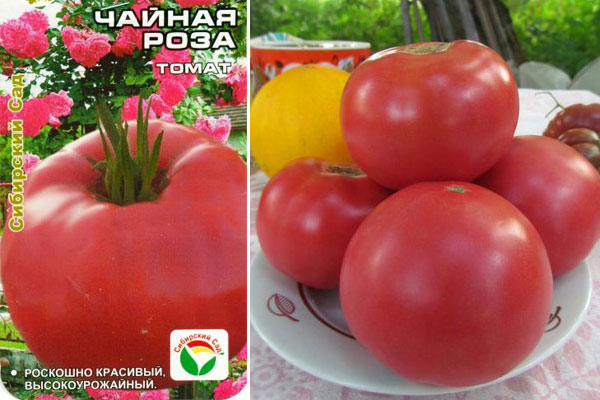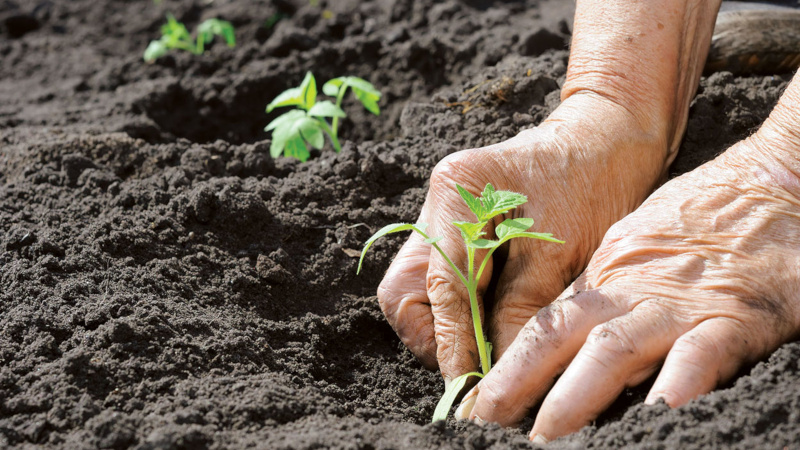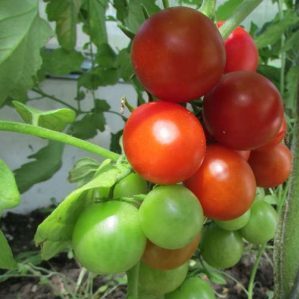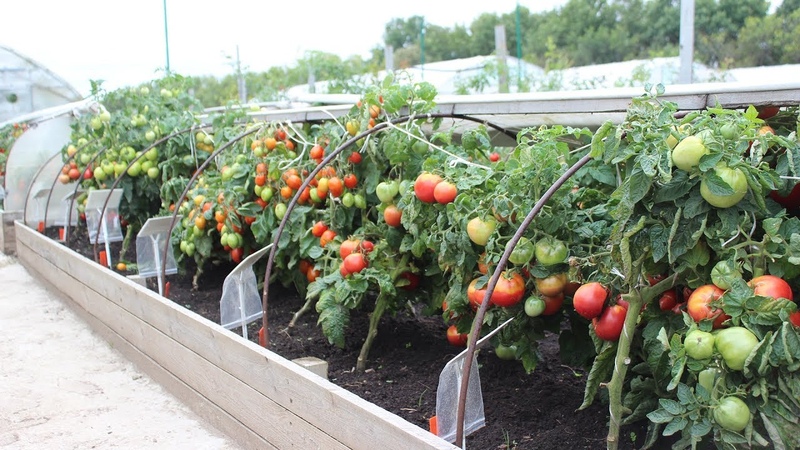Unpretentious in care, but at the same time generous for the harvest tomato "Tea Rose": agricultural technology and advice of experienced farmers
A new product of the Russian selection - the Tea Rose tomato variety can become a decoration of any vegetable garden. This variety is unpretentious, has beautiful bright pink fruits and excellent taste. Basic information about the variety "Tea Rose" will be given below.
The content of the article
Description of the variety
The tea rose is characterized by an impressive height of the bush (up to 2 m), high resistance to diseases and high yield. Full ripening period from 90 to 100 days characterizes the variety as early maturing. The mass of a spherical fruit can reach 0.4 kg.
The average yield per plant reaches 6 kg of fruits, which tolerate transportation and long-term storage well. Fruiting is consistent throughout the entire period of growth and maturation. A decorative appearance to the plant is given by weighty brushes of many (5-7 pieces) fruits on one bush.

Fruit characteristics
Tomatoes have universal qualities, suitable for direct consumption, for the preparation of salads, snacks, sauces and canning for winter. The benefits of the fruit are due to the high content of vitamins, trace elements and useful amino acids. The taste and aroma of the variety are beyond praise. The pulp contains a minimum of water and seeds, is fleshy, resistant to cracking, dense.
The high intensive growth of bushes makes it necessary to tie up and install support posts. This should be counted among the cons of the variety.
How to grow seedlings
Growing tomatoes Tea rose seedlings are best started in the second half of March. Seed material must be carefully prepared in a standard way by soaking or processing with a growth stimulator.
Suitable preparations are available from garden stores. This will help to increase the further germination and productivity of plants.
Capacity and soil
The main requirements for the soil are looseness and nutritional value. Tea rose loves feeding fertilizers. Sod soil with a high content of peat and humus is quite suitable for sowing.
Standard containers are applicable for seedlings, drainage can be laid on the bottom.
Sowing
The seeds are placed in depressions in the soil and sprinkled with loose peat.
After sowing, it is necessary to moisten the soil (liquid fertilizers may be used) and cover it with plastic wrap. This will create a favorable microclimate and help the timely germination of plants.
The development of seedlings requires constant adherence to the temperature regime, in the range of 21-27⁰С.
Growing and care
The culture tolerates moisture and light well. The average germination time of shoots varies from a week to 10 days. This period is enough for the sprouts to grow stronger, and it was possible to remove the film and bring the containers out into the light. These are the necessary conditions for proper acclimatization and hardening of plants before transplanting into the ground.
During this period, seedlings should be watered sparingly, but the soil should not dry out. The variety is quite hygrophilous. Good natural light is essential. After the first shoots appear, they need to be allowed to grow stronger and release at least a couple of sheets. This time is right for a dive.

Planting plants requires preparatory actions, which consist in feeding the plant.Liquid complex fertilizer for nightshades is best suited. This must be done at least twice, immediately before the transplant. The interval between dressings is at least 7 days. It will also not be superfluous to take preventive pest control measures. You can treat the soil with Fitosporin solution.
The soil intended for planting seedlings must be well fertilized and loosened... Manure will do, and the local laying of eggshells will help speed up the development of the tomato root system. It should not be added to the entire soil, but only to the seedling planting sites.
You can plant plants in the ground using a checkerboard pattern. One plant to the usual depth, the next plunges into the ground to the level of the first pair of leaves. This will create convenience in the subsequent care of the bushes and increase the resistance to drying out of the upper layers of the soil.
A suitable irrigation method is drip. The intensity depends on the amount of rainfall and periods of drought. During the flowering period, increased watering is required. It is not advisable to allow the soil to dry out, but excess moisture also leads to the risk of root system disease. You need to keep to the golden mean.
Once a week, you can feed the plant with liquid mineral fertilizers or organic matter.
How to grow tomatoes
Planting plants in open ground must be subject to a number of conditions. This applies to soil, temperature, lighting, and so on.
If the seedling method is meant, then you must first prepare the seedlings by quenching and acclimatization. The right time depends on the climate in the region and on the conditions where the tomatoes will grow. If this is a greenhouse, you can start at the end of May. If the ground is open, it is better to wait until mid-June.
It is recommended to place no more than three plants on one square meter of soil. This will make it easier to access the bushes during subsequent care (watering, fertilizing, tying the bushes).
Care
The variety is characterized by an increased intake of moisture and nutrients. The soil must be fertilized often with complexes of mineral fertilizers. Water for irrigation should not be colder than 15⁰. It should be watered at intervals of 7-12 days. At least 5 liters of water per bush. In dry hot weather, the volume increases to 10 liters. It is recommended to loosen the soil between waterings. This will give additional opportunities for air access and prevent possible rotting of the bush.
Optimum humidity should be within 65 - 70%, air temperature 23-25 температураС.
Features of cultivation and possible difficulties
Plant growth in greenhouse conditions can reach 2 m, in open ground up to 1.5 m. It is necessary to give the plant additional vertical support for one, two stems (posts, pegs). Also, it will not be superfluous to remove side shoots that interfere with the growth of the bush - pinching.
We choose the time for sowing seeds for seedlings with a margin. It should take about 65-70 days before landing in the ground.
Diseases and pests
A big plus of this variety is its high resistance to common diseases and pests.... Compliance with the technique of growing crops reduces the risk of disease to a minimum. Most often, a viral infection affects the Tea Rose. Preventive examinations, mulching, the use of special compounds (Fitosporin) and weeding of the soil will save plants from diseases.
The main insects are pests that infest the Tea Rose: Colorado potato beetle, thrips, whitefly and spider mites. Methods for controlling these pests are typical and well known to all amateur gardeners. Planting herbs next to tomatoes will be a good prevention. The smell of mint or parsley irritates insects.
The nuances of growing in open ground and in a greenhouse
The Tea Rose tomato variety was bred by domestic breeders in 2016, mainly for planting in greenhouses and greenhouses. The stable warm climate of the southern strip of Russia makes it possible for gardeners to grow this variety in the open field.
Differences between greenhouse and open field planting are due to external factors such as the climate in the region. If tomatoes can be planted in a greenhouse already in mid-May, then in open ground not earlier than the first half of June.

In greenhouse conditions, the plant reaches its maximum development. Growth reaches 2 m, yield 6 kg per bush. In the open field, these figures are reduced to 1.5 m and 4.5 - 5 kg.
Greenhouse conditions create their own microclimate, in which it is easier to control and maintain the necessary conditions: air temperature, illumination and humidity. In the open field, the probability of night freezing of the plant increases, the culture is exposed to cold air currents.
The Tea Rose tomato variety loves good lighting. In winter, you need to artificially increase the daylight hours. It is easier to do this in a greenhouse, turning off artificial lighting for 6 - 8 hours a day.
To water in the open field you need warm water, 16 - 18⁰С. In a greenhouse, it is permissible to use water no colder than 15⁰С.
Both in the open and in the closed ground, fertilization of the crop is carried out throughout the entire ripening period.
Harvesting and application of the crop
Subject to the cultivation technology, the tea rose tomato variety will delight gardeners with an abundant harvest of fruits of an ideal round shape. The size of the tomatoes on the same bush may vary. This is a plus of the variety. Large ones will be used for salads, appetizers, and cuts. Mediums are ideal for canning for the winter.
The taste qualities of the variety do not leave indifferent the most fastidious gourmets. The fruits are well stored, do not lose their taste, are quite resistant to cracking and tolerate transportation well. Gathering unripe fruits with the prospect of ripening has no practical meaning.
Advantages and disadvantages
The main disadvantage when growing the Tea Rose variety is the need to provide the plant with additional support (tying, driving in vertical pegs) and pinching. Also, the plant requires regular feeding with mineral fertilizers throughout the entire maturation cycle.
The main advantages of the Tea Rose variety:
- Excellent taste of the fruit.
- High productivity.
- The fruits are well transported, resistant to damage.
- A beautiful decorative view of the plant in the garden.
- Tomatoes are rich in vitamins and amino acids.
- Cold resistance of the grade.
- The fruits are suitable for raw consumption, cooking, canning.

Farmers reviews
Here are the reviews of gardeners who have grown the Tea Rose tomato variety in practice.
Marina, Rostov-on-Don: “Thanks to the breeders for this hybrid. Grew up in the country last year. I was very pleased. I will definitely continue to plant Tea Rose tomatoes.
Ignat, Volgograd: “I planted the Tea Rose tomato variety in 2016. I was delighted with the good harvest and the absence of diseases. Thanks to Russian agronomists! "
Liana, Smolensk: “I grew the variety in my greenhouse. I had to tinker a bit when tying up bushes and loosening the beds. But the good harvest has more than paid for all the efforts. "
Conclusion
The Tea Rose tomato variety appeared only three years ago, but managed to earn attention and positive reviews from farmers from all over Russia. This successful brainchild of domestic breeders will take its well-deserved place in the garden plots of most gardeners.